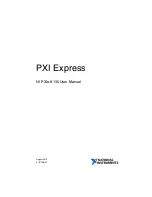
© National Instruments
|
1-1
1
Introduction
This chapter provides overview information for PXI Express and the NI PXIe-8135 embedded
controller.
Benefits of PXI Express
The PXI (PCI eXtensions for Instrumentation) industry standard, an open specification governed
by the PXI Systems Alliance (PXISA), has quickly gained adoption and grown in prevalence in
test, measurement, and control systems since its release in 1998. One of the key elements driving
the rapid adoption of PXI is its use of PCI in the communication backplane. As the commercial
PC industry has improved the available bus bandwidth by evolving PCI to PCI Express, PXI is
now able to meet even more application needs by integrating PCI Express into the PXI standard.
By taking advantage of PCI Express technology in the backplane, PXI Express increases the
available PXI bandwidth from up to 132 MB/s to up to 8 GB/s for a more than 60x improvement
in bandwidth.
PXI Express maximizes both hardware and software compatibility with PXI modules.
PXI Express hybrid slots deliver both PCI and PCI Express signaling to accept devices that
use PXI communication and triggering or the newer PXI Express standard. Software
compatibility is maintained because PCI Express uses the same OS and driver model as PCI,
resulting in complete software compatibility among PCI-based systems, for example PXI, and
PCI Express-based systems such as PXI Express.
PXI Express, like PXI, leverages from the CompactPCI specification to define a rugged,
modular form factor that offers superior mechanical integrity and easy installation and removal
of hardware components. PXI Express products offer higher and more carefully defined levels
of environmental performance required by the shock, vibration, temperature, and humidity
extremes of industrial environments. Mandatory environmental testing and active cooling is
added to the CompactPCI mechanical specification to ease system integration and ensure
multivendor interoperability.
The demanding timing and synchronization requirements of instrumentation systems are met by
the integrated features of PXI Express. Not only are the trigger bus, 10 MHz system reference
clock, and star trigger bus available in PXI retained by PXI Express, but new timing and
synchronization features that include a 100 MHz differential system reference clock for the
synchronization of multiple modules and three differential star trigger buses for the distribution
of precise clock and trigger signals have been added. Differential timing and synchronization
signals provide PXI Express systems with increased noise immunity and the ability to transmit
clock signals at higher frequencies.











































